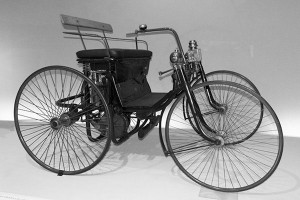Quick quiz — what do famous musicians Daniel Barenboim, Harry Connick, Jr., Billy Joel, Benjamin Britten, Duke Ellington, George Gershwin, Cole Porter and Vladimir Horowitz, have in common with Gottlieb Daimler, German inventor of one of the first motor cars?
Well, actually, not much.
Except that the above named musicians all played Steinway pianos, while Steinway once built Daimler-Steinway engines at the same location as the famous Steinway pianos were made.
Meanwhile, in Long Island just east of New York City, William Steinway had established a company town called Steinway, with a new piano factory, foundry and sawmill, along with houses, and a school, library, post office and fire department, for the workers who made the famous Steinway pianos.
Heinrich Steinweg had made pianos in Seesen, Germany, and his sons all learned the trade as well. About 1850, most of the family immigrated to America, changed their name to Steinway, and established a piano factory in NYC. Heinrich’s son William, who took over as Steinway president in 1889, had traveled to Germany in 1888 and heard of Gottlieb Daimler’s new engine, became interested, and visited the inventor in Bad Canstatt (today a part of Stuttgart and the location of the Mercedes-Benz Museum).
According to the November, 1895, issue of Horseless Age, (which was, by the way, the magazine’s very first issue), he took “a jaunt around the country in a light quadricycle propelled by a Daimler motor.”
Impressed

The “jaunt” sufficiently impressed Steinway that he signed a contract with Daimler for the American manufacturing rights to the engine. A “quadricycle” was basically two bicycles joined side by side with an engine for power and a seat for the driver and maybe a passenger or two.
Something new
Steinway returned to the states and established the Daimler Motor Co.
He contracted with the National Machine Co. in Hartford, Connecticut, to build the first engines; although Horseless Age tells us that, “The splendid record made by the Daimler motor in the Paris-Bordeaux race last June has so stimulated demand for Daimler motors in America, that a special building adapted to their manufacture is being constructed at Steinway.”
Although there was no Daimler-built car in this race, the Peugeot and Panhard & Levassor cars that shared first prize both used Daimler engines. The French newspaper that had sponsored the event, Le Petit Journal, commented afterward, “The Daimler engine … has turned gasoline or petroleum fuel into a practical solution.”
The Steinway-Daimler power plant seems to have become very popular with boatmen and the motor launch business grew rapidly.
Familiar sights
The same article says that “Daimler Motor Launches are familiar sights in New York waters, as well as in regions more remote, their reputation for speed, economy, and general serviceableness being unsurpassed.”
Steinway continued to build pianos and Daimler engines. It’s doubtful if they actually built any Daimler Motor Carriages in their factory, but they must have imported some from Germany.
The January 1896, issue of Horseless Age reports the following: “The Daimler Motor Co., Steinway, L.I., have advice from their superintendent, Mr. Fred Kuebler, now in Europe, that a consignment of improved Daimler carriages will arrive in N.Y. about February 1.”
William Steinway died Nov. 30, 1896, at age 61, and his family decided to get out of the engine business. They sold the Long Island plant and Daimler rights to General Electric in 1898, but retained the piano business. G.E. made some Daimler-powered delivery wagons, as well as the wildly expensive American Mercedes cars that were copies of the Daimler-built Mercedes. This all ended in 1907, when the factory was destroyed by fire and G.E. apparently lost interest in cars.
Of course, Daimler survived in Germany, although it was merged with long-time rival, Benz, in 1926, and today it has a large presence in this country with Mercedes-Benz cars and vans and the wee Smart cars.
New car
Although the Steinway-Daimler name disappeared more than a century ago, there’s a new car on the market named the Steinway & Sons 7. German car maker BMW, a competitor of Daimler, entered a joint project with piano maker Steinway & Sons back in 2011 to produce a special version of the big BMW 7 series.
The Steinway & Sons 7 comes only in black or white (to match a piano keyboard) with the contrasting interior color—black exterior, white interior, and vice versa. The super-luxurious interior is genuine leather, of course, and the Steinway logo, a gold lyre, is embossed on the leather of each seat back. The exterior finish consists of three layers of clear-coat, each hand-rubbed over the color coat, giving it “a surface quality comparable to high-class piano lacquer.” The cars have a gold “coachline” along each side, 20-inch alloy wheels and are pretty impressive looking rides.
I couldn’t find a price for the car but the high-end BMW 760i, on which the Steinway 7 is based, starts at more than $140,000.
Now, before you dash off to your BMW dealer to get one, you should know a couple of things: first, the Steinway 7 was only offered to the Chinese market — I guess BMW figured the Chinese were the only ones who could afford it. Second, the car was a limited edition with only 150 planned to be made, making the likelihood of finding one mighty slim. So, I guess Steinway pianos are about as close to high culture as this column will ever get.












